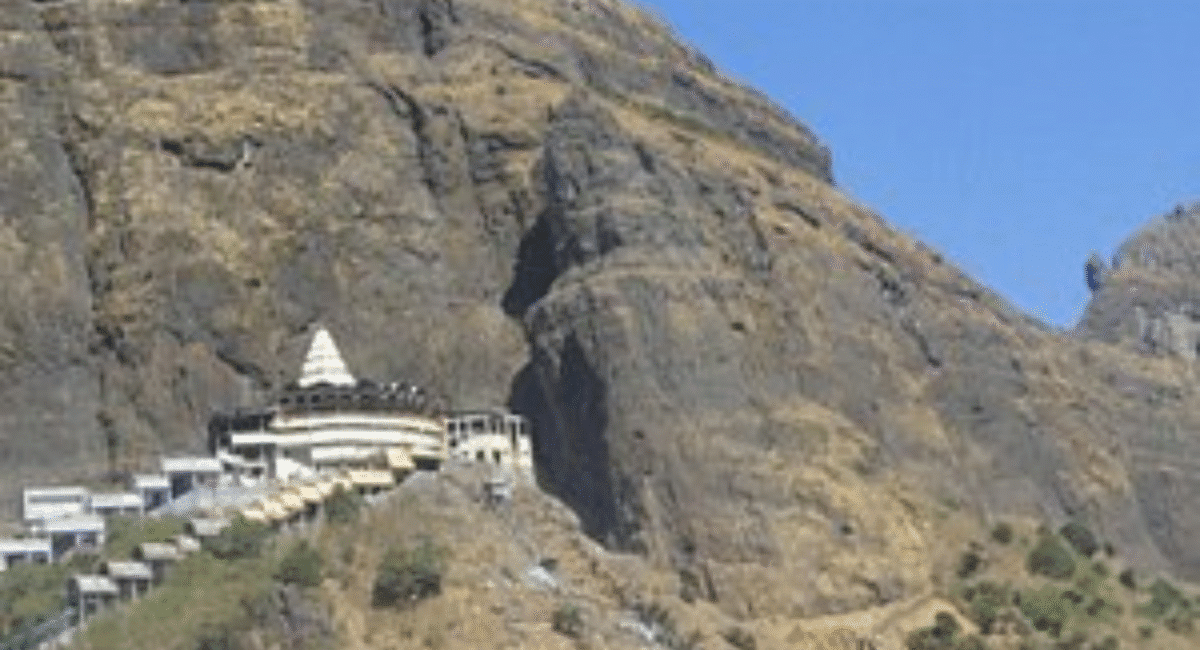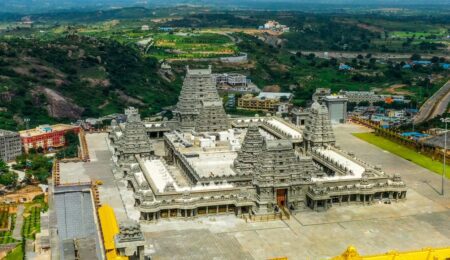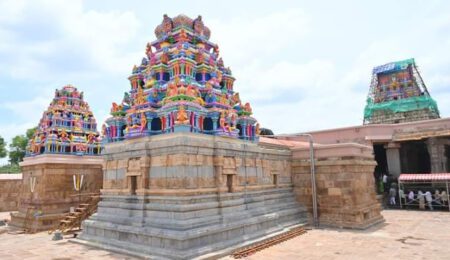Shri Sant Nivruttinath Maharaj Samadhi
Located at the foothills of Brahmagiri near the sacred Trimbakeshwar temple in Nashik district, the Shri Sant Nivruttinath Maharaj Samadhi is a quiet yet powerful center of devotion and spiritual memory. Sant Nivruttinath elder brother and guru of the great saint-poet Dnyaneshwar is a key figure in the Marathi Bhakti and Nath traditions. His Samadhi (resting place) at Trimbakeshwar draws devotees, warkaris, scholars and seekers who come to honor his life, teachings and the living spiritual tradition that continues around the site.
Who was Sant Nivruttinath? — A concise life sketch
Sant Nivruttinath (Nivrutti Vitthalpant Kulkarni) was born in the 13th century and is remembered as a saintly yogi, teacher and an early exponent of the Nath and Varkari paths in Maharashtra. He was the eldest sibling and spiritual guide of Sant Dnyaneshwar, whose Dnyaneshwari (a Marathi commentary on the Bhagavad Gita) remains one of the most influential works in Marathi spirituality and literature. Nivruttinath was initiated into the Nath tradition by Gahaninath and later guided his younger brothers and sister on the path of devotion and inner realization.
According to traditional accounts, after family trials and the extraordinary spiritual events surrounding Dnyaneshwar’s life, Nivruttinath undertook extended pilgrimages and spiritual practices and eventually took Sanjeevan (Jeev) Samadhi at Trimbakeshwar. The site where he entered Samadhi became a place of veneration and a focal point for the Nath lineages and the warkari movement.
Historical background of the Samadhi at Trimbakeshwar
The Samadhi at Trimbakeshwar is historically significant both for its association with Sant Nivruttinath and for its role in the region’s living religious culture. Multiple local histories and temple records note that the Samadhi has been a place of pilgrimage for centuries, with devotees and Gosavi families preserving the tradition of worship and care for the shrine. There are records of temple structures and patronage evolving over time as the Trimbakeshwar temple complex developed under local rulers and later trustees.
The Trimbakeshwar region itself is ancient — famous for the Trimbakeshwar Shiva temple and the Brahmagiri hill (source of the Godavari river) — and it naturally became an important religious landscape for numerous saints, including Nivruttinath, whose Samadhi is located near these sacred places. The Samadhi site is at the base of Brahmagiri and lies within the broader pilgrimage circuit that connects Trimbak with other Maharashtra holy sites.
Temple architecture and the Samadhi complex
The Shri Sant Nivruttinath Maharaj Samadhi Mandir is modest in scale compared with large temple complexes, but its architectural and devotional arrangement reflects the sanctity of Jeev Samadhi sites:
- Samadhi Shrine (Garbhagruha): The heart of the complex is the samadhi mound/shrine itself where the saint’s final meditation took place. Devotees offer flowers, incense and traditional offerings here.
- Mandap and Congregation Hall: A simple mandap (prayer hall) is used for kirtans, abhangs (devotional songs), and collective readings of the Dnyaneshwari and other abhang literature.
- Palkhi and Procession Area: Space is allocated for the palkhi (palanquin) that begins from Trimbakeshwar during the annual warkari yatra. The surrounding area acts as the ceremonial launch point for the procession. Recent local reports and news coverage describe the palkhi’s ceremonial start at the Kushavart pond and near the Trimbakeshwar temple.
- Waters and Grove: The Samadhi sits close to groves and streams at the foothill, which add to the meditative atmosphere particularly vibrant during the monsoon season. Local conservation/plantation drives are occasionally held to maintain the green canopy around the mandir.
The architecture is purposely unostentatious: humility and simplicity reflect the Nath ethos. The temple’s physical features are designed to accommodate devotional singing and collective worship more than elaborate ritual theatre.
Spiritual and cultural significance
Guru of Dnyaneshwar and Nath lineage
Nivruttinath’s role as guru to Dnyaneshwar gives his Samadhi special weight for followers of the Varkari tradition and students of Marathi bhakti literature. The lineage connections (Gahaninath → Nivruttinath → Dnyaneshwar) place the Samadhi within a chain of transmission that is still celebrated and recited in devotional songs and scholarly works.
Living tradition — abhangs, kirtans and the palkhi
The Samadhi is not only a historical monument; it is a living space where abhang-kirtan traditions continue. The palkhi (palanquin procession) associated with Sant Nivruttinath begins from Trimbakeshwar and moves toward Pandharpur, joining the long-established warkari pilgrimage cycle that culminates at Vithoba’s temple during Ashadi Ekadashi. These processions keep oral traditions, songs and communal service alive. Recent coverage confirms that the palkhi route and its ceremonies remain active and attract thousands of devotees.
Social and ethical teachings
Nivruttinath and his siblings emphasized devotion (bhakti), humility, and inner realization over ritualism and caste prejudice. Their life stories and teachings are woven into local ethics, community help (anna-daan and seva), and the pilgrimage culture that sustains villages and towns along the palkhi route.
Major festivals and events
The Samadhi is a focal point for several annual events, often synchronized with the broader warkari calendar:
- Palkhi (Annual Warkari Procession): The most visible event is the palkhi that starts in Trimbakeshwar and proceeds over weeks to Pandharpur, timed to reach in advance of Ashadi Ekadashi. The palkhi includes chanting, abhangs, communal meals and stops at important waypoints across Nashik and neighboring districts. Local authorities organize traffic diversions and security measures during the procession due to the large crowds.
- Guru Purnima: Devotees gather for special pujas and discourses honoring the guru-shishya lineage.
- Ashadi Ekadashi & Kartiki Ekadashi Events: Though these are primarily associated with Pandharpur and Vithoba, warkari centers such as Nivruttinath’s Samadhi play active roles in pre- and post-festival gatherings—singing abhangs and organizing community meals.
- Daily and Weekly Bhajan/Kirtan Sessions: Small-scale but consistent devotional singing events keep the devotional calendar active year-round.
Visiting Shri Sant Nivruttinath Maharaj Samadhi — Practical guide
Location & how to reach
- Where: The Samadhi Mandir is at Trimbakeshwar (Trimbak), Nashik district, Maharashtra, near the Trimbakeshwar Shiva temple and at the base of Brahmagiri hill. Map listings and local travel guides place the Samadhi along Nivrutti Nath Road/Trimbak Road in Trimbak.
- By Air: The nearest major airport is Nashik’s Ozar Airport (Nashik Airport); Pune Airport and Mumbai Airport are alternative gateways with more frequent flights. From any airport, private taxi or rendezvous via Nashik city will get you to Trimbakeshwar (about 28 km from Nashik city).
- By Train: Nashik Road Railway Station (IS code: NK) is the primary railhead. From Nashik Road, regular bus or taxi services connect to Trimbakeshwar.
- By Road: Trimbak is well connected by state transport buses and private vehicles. Road journeys from Nashik city take around 45–60 minutes depending on traffic.
Best time to visit
- Monsoon (June–September): Brahmagiri and the surrounding hills are lush and scenic; however, heavy rains can make travel tricky. The samadhi area is particularly beautiful after rains.
- Winter & Post-monsoon (October–March): Pleasant weather and comfortable pilgrimage conditions ideal for long walks and attending outdoor processions.
- Festival times (June–July for palkhi lead-up): Expect large crowds—book accommodation early and be prepared for processional activities.
Timings & practicalities
- Typical opening hours: Many small samadhi shrines and associated mandaps open early (around 5:00–6:00 AM) and close after evening arti (around 7:00–9:00 PM). Exact timings can vary; local listings show standard temple hours but verify locally on arrival.
- Dress code & etiquette: Modest, respectful attire is expected. Remove footwear before entering sanctified spaces, maintain silence in the samadhi chamber, and avoid flash photography within inner sanctums.
- Facilities: Being a smaller shrine, amenities are basic small shops selling prasad, tea stalls, and simple lodging in Trimbak/Nashik. For more comfort, stay in Nashik city and make a day trip to Trimbakeshwar.
Accommodation & food
- Accommodation: Trimbak has guest houses and dharamshalas; Nashik offers a wider range (budget hotels to premium stays). During palkhi and major festivals, accommodation in Trimbak fills fast—book ahead.
- Food: Simple vegetarian food and local Maharashtrian fare (thali, bhakri, varan-bhaat, misal-pav in Nashik) are readily available. Community langars or bhiksha arrangements sometimes occur during pilgrimages.
Tips for pilgrims and visitors
- Plan around the palkhi if you want to witness it: The procession is a living tradition and a powerful communal spiritual experience. If you want to join or watch, plan travel and accommodation early.
- Carry water and basic medicines: Mountain roads and crowded processions can be tiring; a small first-aid kit helps.
- Respect local customs: Participate humbly join abhang singing if invited, but observe if unsure.
- Photography: Use discretion. Inner sanctums and samadhi mounds are often sensitive areas—ask before taking photos.
- Combine nearby sacred sites: Trimbakeshwar Shiva temple, Brahmagiri hill and nearby natural spots make for a meaningful multi-site pilgrimage day.
What you’ll experience — beyond the facts
Visiting Nivruttinath’s Samadhi at Trimbakeshwar is less about grand monuments and more about felt presence. The combination of devotional singing, the rhythm of the palkhi, the hush around the samadhi, and the green slope of Brahmagiri creates an atmosphere conducive to inner reflection. Many devotees report a strong sense of continuity with the past—sitting where saints once meditated and hearing the same abhang melodies sung across centuries.
For scholars and seekers alike, the site is a living textbook on how spiritual lineages are preserved through songs, processions, and everyday acts of worship rather than through monumental stone alone. The Samadhi’s quiet simplicity is itself a teaching.
Conservation, community and recent activity
Local groups and trusts periodically engage in conservation activities—tree-plantations, clean-up drives and small renovations to maintain the mandir and its surroundings. News reports and local NGOs sometimes run initiatives to support the palkhi and preserve the cultural route. For the most recent community events, checking Nashik district announcements or Trimbakeshwar trust pages is helpful.
Conclusion
The Shri Sant Nivruttinath Maharaj Samadhi at Trimbakeshwar is a compelling destination for anyone interested in Maharashtra’s spiritual history, the Nath and warkari traditions, or devotional practice. It is a modest place with a profound legacy: the teachings and presence of a saint who shaped one of the most influential spiritual movements in western India. Whether you come for the palkhi, to sing abhangs, or to sit quietly by the samadhi mound, Trimbakeshwar offers a sincere, grounding pilgrimage experience.
Frequently Asked Questions
Q1: Where is Sant Nivruttinath Maharaj Samadhi located?
A: The Samadhi is at Trimbakeshwar (Trimbak), Nashik district, near the Trimbakeshwar Shiva temple and at the foothills of Brahmagiri.
Q2: Is Sant Nivruttinath the guru of Dnyaneshwar?
A: Yes. Nivruttinath served as the spiritual guide to his younger brother Sant Dnyaneshwar, and their relationship is central to Marathi bhakti history.
Q3: When did Nivruttinath take Samadhi?
A: Traditional sources record Nivruttinath’s samadhi in the late 13th century (accounts often cite dates around 1297 CE, with some local traditions noting differing calendar markers tied to lunar dates). The resting place is at Trimbakeshwar.
Q4: What is the palkhi and when does it start from Trimbakeshwar?
A: The palkhi is a palanquin procession of warkaris carrying the padukas (holy sandals) or symbolic representations. The Sant Nivruttinath palkhi traditionally starts from Trimbakeshwar and makes its way toward Pandharpur to join the Ashadi Ekadashi festivities; timings vary year to year but are usually in June–July for the Ashadi route. Recent reports indicate active palkhi departures from Trimbakeshwar and associated community arrangements.
Q5: Can tourists visit the Samadhi?
A: Yes. The Samadhi is open to all visitors pilgrims and tourists alike. Respect local customs and timings and avoid bringing meat, tobacco products or alcohol to the temple premises.




Leave a Comment